Engineering:Blackbird (land yacht)
Blackbird is an experimental land yacht, built in 2010 to demonstrate that it is possible to for a wind-powered vehicle to go directly downwind faster than the wind. The vehicle employs a rotor connected to the wheels and does not have a motor, battery or flywheel.[1] It was constructed by Rick Cavallaro and John Borton of Sportvision, sponsored by Google and Joby Energy in association with the San Jose State University aeronautics department.
In a test supervised and recognized by the North American Land Sailing Association in July 2010, Cavallaro achieved a speed of 27.7 mph (44.6 km/h) sailing directly downwind in 10 mph (16 km/h) winds: almost three times the speed of the wind.[2][3][4][5] In 2012, Blackbird also demonstrated sailing directly upwind with twice the speed of the wind.
Theory
Gaunaa, et al. describe the physics of rotor-powered vehicles. They describe two cases, one from the vantage point of the earth and the other from the vantage point of the air stream and come to the same conclusions from both frames of reference. They conclude that (apart from forces that resist forward motion):[6]
- There is no theoretical upper limit to how fast a rotor-driven craft can go directly upwind.
- Likewise, there is no theoretical upper limit to how fast a rotor-driven craft can go directly downwind.
These conclusions hold both for land and water craft.
Required for wind-powered vehicle (or water craft) motion are:[6]
- Two masses moving with respect to each other, e.g. the air (as wind) and the earth (land or water).
- The ability to change the velocity of either mass with a propeller or a wheel.
In the case of a rotor-powered vehicle, there is a drive linkage between the rotor and the wheels. Depending on one's frame of reference—the earth's surface or moving with the air mass—the description of how available kinetic energy powers the vehicle differs:[6]
- As seen from the vantage point of the earth (e.g. by a spectator), the rotor (acting like a wind turbine) decelerates the air and drives the wheels against the earth, which it accelerates imperceptibly.
- As seen from the vantage point of the air stream (e.g. by a balloonist), the wheels impede the vehicle—decelerating the earth imperceptibly—and drive the rotor (acting like a propeller), which accelerates the air and propels the vehicle.
The connection between the wheels and the rotor causes the rotor to rotate faster with increasing vehicle speed, thereby allowing the rotor blades to continue to obtain forward lift from the wind (as seen from the ground) or to propel the vehicle (as seen from the air stream).[6]
History
In 2006, following a viral internet debate started by Rick Cavallaro as a brain teaser,[2] a propeller-driven land yacht was built and filmed, demonstrating that it is possible to sail 'dead' downwind faster than the wind by the power of the available wind only.[7]
In 2009, professor Drela of MIT worked out the equations for such a device and concluded that one could be built "without too much difficulty".[8] Other researchers arrived at similar conclusions.[6]
In the same year, after being challenged that the video was a hoax, team members Rick Cavallaro and John Borton of Sportvision, sponsored by Google and in association with the San Jose State University aeronautics department, built a test vehicle nicknamed Blackbird. A year later, in 2010, Cavallaro successfully tested the vehicle, achieving more than 2 times the speed of wind,[2] definitively demonstrating that it is possible to build a vehicle which can achieve the claim.[9][4] A second test with an improved vehicle in 2011 reached close to 3 times the speed of wind.[5]
After proposing the vehicle's design, and presenting the analysis to demonstrate its viability, the Blackbird team learned that others had previously conceived and built similar designs—most notably aerodynamics engineer Andrew B. Bauer, later with the Douglas Aircraft Company, built and demonstrated such a vehicle in 1969, based on an analysis presented in a student's paper from some 20 years earlier.[10][11]
Bauer reported "a rearward deflection of a foot-long tuft located about 12 feet forward of the propeller plane" indicating that his vehicle went faster than the true wind. (The strand would have streamed forward if the apparent wind was from behind.) Several sources of engineering and scientific articles explain the theory and physics of such a device.[8][6] Besides still photography, a film has been found showing it in operation.[12]
Achievements
On 7 and 8 March 2010, the team reported testing their vehicle on a motor-driven moving belt (treadmill), showing that it would advance against the belt, which means that it can progress dead downwind faster than the wind.
On 24 March 2010, the team ran the vehicle on the Ivanpah dry lake bed south of Las Vegas, Nevada, showing that it could accelerate dead downwind from a standstill and reach velocities well in excess of wind speed.[3][13][14] That is, the vehicle was progressing dead downwind faster than the wind. Officials of the North American Land Sailing Association (NALSA) were in attendance and one NALSA Board of Directors member (Bob Dill) was there for every run and collected his own rough wind and GPS data.[15] This was not a NALSA-sanctioned event but was presented as a demonstration to the NALSA Board of Directors that the vehicle was capable of progressing dead downwind faster than the wind. Subsequently, the team worked out the details with NALSA for rules and instrumentation related to an upcoming official NALSA ratified test and record.
On July 2, 2010, Blackbird set the world's first certified record for going directly downwind, faster than the wind, using only power from the available wind during its run on El Mirage Dry Lake. The yacht achieved a dead downwind speed of about 2.8 times the speed of the wind.[1][16]
On June 16, 2012, Blackbird set the world's first certified record for going directly upwind, without tacking, using only power from the wind. The yacht achieved a dead upwind speed of about 2.1 times the speed of the wind.[1]
See also
- Greenbird – wind-powered vehicle that set 126.1 mph (202.9 km/h) land speed record on March 26, 2009 (not directly downwind)
- List of motorized trikes
External links
- Archived Blackbird project website, with pictures and speed graph
- North American Land Sailing Association
- Video of Blackbird on YouTube
- Downwind Noir (article by Kimball Livingstone)
References
- ↑ 1.0 1.1 1.2 "Direct Upwind and Downwind Record Attempts". May 16, 2013. http://www.nalsa.org/DownWind.html.
- ↑ 2.0 2.1 2.2 Rick Cavallaro (August 27, 2010). "A Long, Strange, Trip Downwind Faster Than the Wind". Wired. https://www.wired.com/autopia/2010/08/ddwfttw/all/1. Retrieved 2010-09-14. - Explanation of the Blackbird workings and its physics.
- ↑ 3.0 3.1 Cort, Adam (April 5, 2010). "Running Faster than the Wind". sailmagazine.com. Archived from the original on 21 September 2013. https://web.archive.org/web/20130921061617/http://www.sailmagazine.com/running-faster-wind/. Retrieved January 9, 2012.
- ↑ 4.0 4.1 Barry, Keith (June 2, 2010). "Wind Powered Car Travels Downwind Faster Than The Wind". wired.com. https://www.wired.com/autopia/2010/06/downwind-faster-than-the-wind/. Retrieved July 1, 2010.
- ↑ 5.0 5.1 Adam Fischer (February 28, 2011). "One Man’s Quest to Outrace Wind". Wired. https://www.wired.com/magazine/2011/02/ff_fasterthanwind/. Retrieved 2012-07-03.
- ↑ 6.0 6.1 6.2 6.3 6.4 6.5 Gaunaa, Mac; Øye, Stig; Mikkelsen, Robert (2009), "Theory and Design of Flow Driven Vehicles Using Rotors for Energy Conversion", Proceedings EWEC 2009, Marseille, http://orbit.dtu.dk/fedora/objects/orbit:55484/datastreams/file_3748519/content
- ↑ Goodman, Jack (January 2006). "Down wind faster than the wind". Catalyst (Journal of the Amateur Yacht Research Society). http://www.ayrs.org/DWFTTW_from_Catalyst_N23_Jan_2006.pdf. Retrieved 2010-09-21.
- ↑ 8.0 8.1 Drela, Mark (1 January 2009). "Dead-Downwind Faster Than The Wind (DFTTW) Analysis". https://www.blueplanettimes.com/wp-content/uploads/2010/08/Drela-DDWFTTW-Analysis.pdf. Retrieved December 20, 2020.
- ↑ Cort, Adam (April 5, 2010). "Running Faster than the Wind". sailmagazine.com. Archived from the original on September 21, 2013. https://web.archive.org/web/20130921061617/http://www.sailmagazine.com/running-faster-wind/. Retrieved January 9, 2012.
- ↑ Bauer, Andrew (1969). "Faster Than The Wind". Marina del Rey, California: First AIAA Symposium on Sailing. http://projects.m-qp-m.us/donkeypuss/wp-content/uploads/2009/06/Bauer-Faster-Than-The-Wind-The-Ancient-Interface.pdf., Picture of Bauer with his cart
- ↑ "Sad News in the World of DDFTTW". Faster Than The Wind Team. September 14, 2010. Archived from the original on November 10, 2010. https://web.archive.org/web/20101110032413/http://www.fasterthanthewind.org/2010/09/sad-news-in-world-of-ddwfttw.html. Retrieved 2015-01-13..
- ↑ "Andrew Bauer Wind Machine 1969 (no audio)". https://www.youtube.com/watch?v=yFPomTq_PRU.
- ↑ Boyle, Rebecca (June 2, 2010). "Wind Powered Actually Moves Faster Than Wind Speed, Answering Tricky Physics Question". popsci.com. http://www.popsci.com/cars/article/2010-06/wind-powered-car-looks-odd-answers-tricky-physics-question. Retrieved July 1, 2010.
- ↑ Barry, Keith (July 8, 2010). "Team Goes Downwind 2.5 Times Faster Than the Wind". Wired Magazine. https://www.wired.com/autopia/2010/07/downwind-faster-than-the-wind-possible-and-theyll-prove-it. Retrieved August 6, 2010.
- ↑ "Testing graph". The Faster Than the Wind Team. 18 May 2010. http://www.fasterthanthewind.org/2010/05/testing-graph.html.
- ↑ Livingston, Kimball (1 August 2010). "A NALSA Record: DDWFTTW". Archived from the original on 15 November 2010. https://web.archive.org/web/20101115102044/http://kimballlivingston.com/?p=3922.



